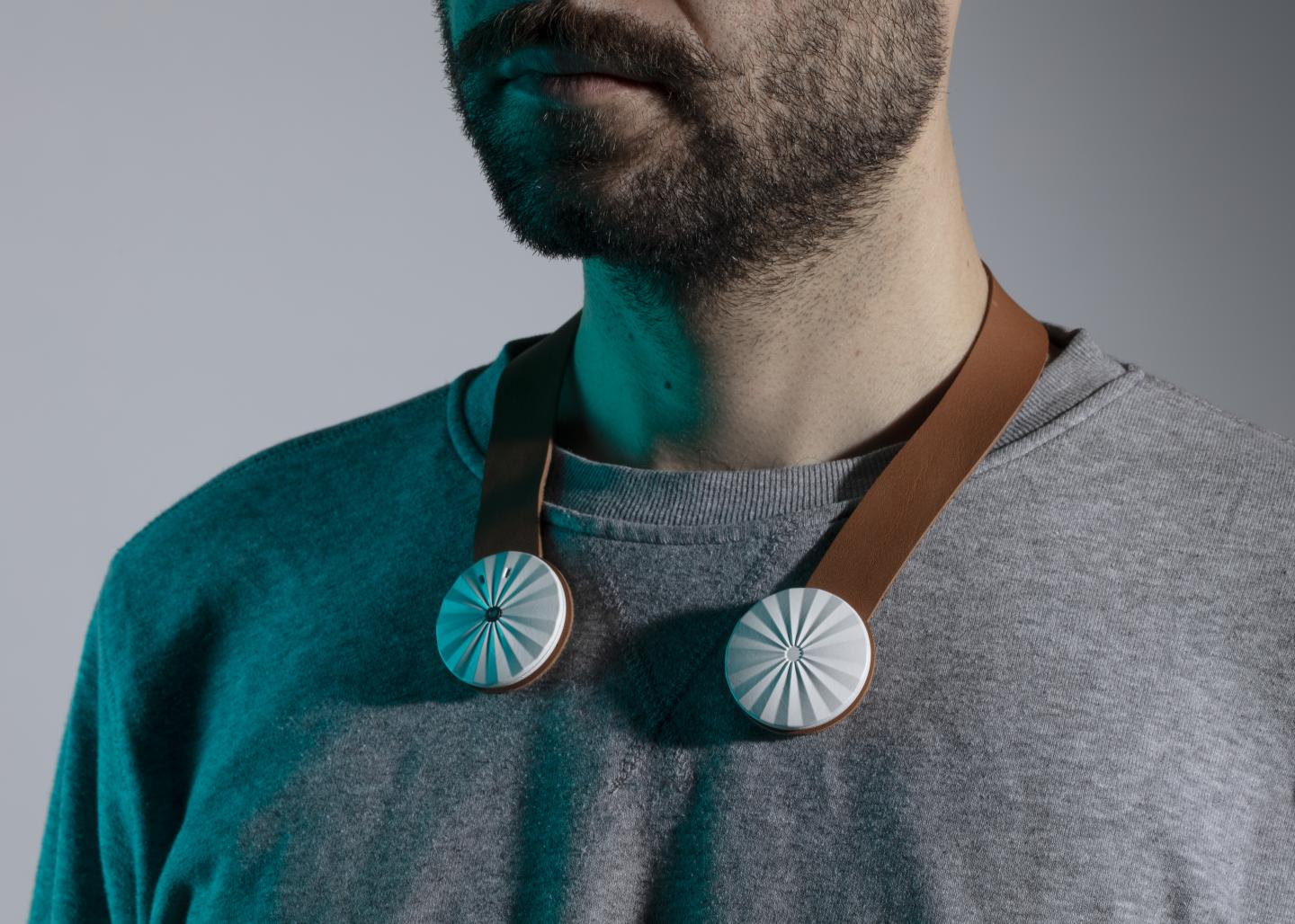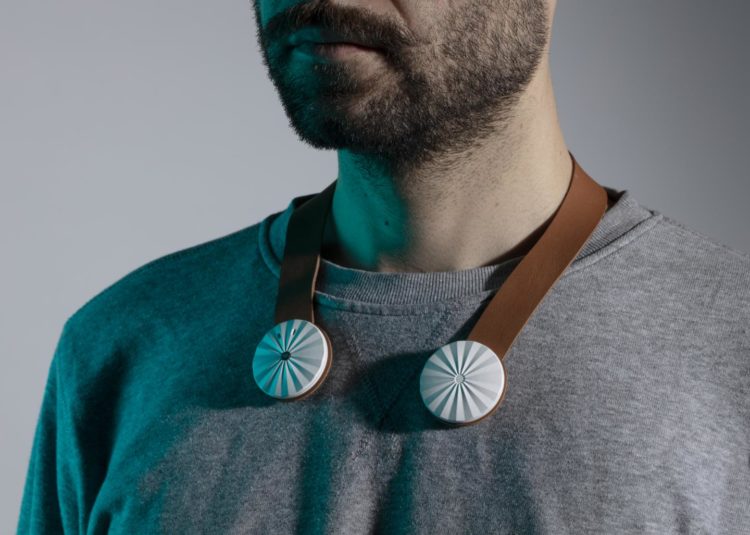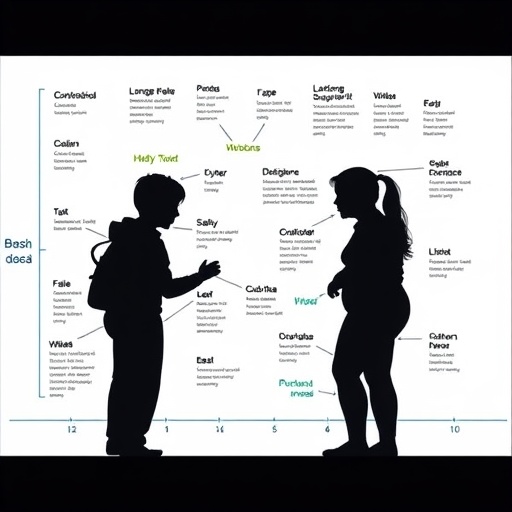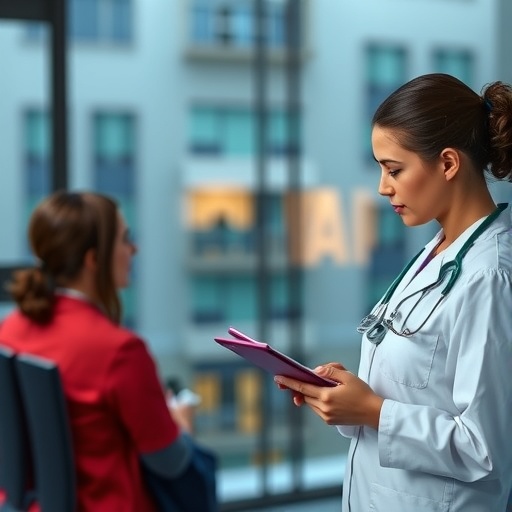
Credit: © HEAD-Baptiste Coulon
How much light do you receive over the course of a day? What type of light enters your eyes? Spectrace, a new piece of wearable tech, could soon provide the answers to these questions. In a groundbreaking move, researchers at EPFL’s Laboratory of Integrated Performance in Design (LIPID) have teamed up with teachers and students from Geneva School of Art and Design (HEAD – Genève) to develop a light sensor concept. The device, which rests around the neck like a pair of headphones or can be attached to an item of clothing with a magnetic pin, is designed to be worn all day long – at work, during exercise and in social settings.
The project has just been awarded an InnoSuisse grant in the eHealth category. Earlier this year, the project received support through an Explorer Grant from the ENAC InnoSeed program at EPFL. This new funding will be used to develop a modular, working prototype and test it in real-world conditions by 2021, with the aim of founding a spin-off to bring the Spectrace sensor to the wider scientific community and the general public.
Circadian rhythms
Since the discovery of melanopsin 20 years ago, scientists have taken a growing interest in how a shortage of natural light and excessive exposure to artificial light from screens affect our bodies. Melanopsin, a blue-light-sensitive photopigment found in the human eye, helps keep the body’s internal clock on track and tells our brain whether it’s day or night. It is responsible for synchronizing all our circadian rhythms, and this has a significant impact on our health, from regulating our sleep and our hormone cycle – including the production of melatonin at night – to the ability of our immune system to function properly.
“We urgently need to pay more attention to our ‘light hygiene’,” says Professor Marilyne Andersen, the director of LIPID and an expert in the field for some 15 years. “We spend so long indoors, which means we’re suffering from a chronic shortage of daylight, and staring at screens all the time, which has especially negative effects at night. We should in fact be getting plentiful light that is rich in blue wavelengths during the day, in order to accumulate a sufficient amount, as this will make us feel better, and limiting this exposure well before bedtime.”
Gap to fill
Various types of wearable light sensors exist on the market. Yet none of them can truly measure our exposure to the spectral range of light, i.e., as a function of the light’s wavelength (all the constituent “colors”). That’s what’s new about the prototype developed by EPFL. There is currently not enough data on the type of light to which we are actually exposed as a result of our daily activities and the environment in which we live and work. The physiological effects of light depend not only on its intensity and how long we’re exposed to it, but its spectrum as well. That’s the gap that the new Spectrace sensor is meant to fill.
Forrest Webler, as part of his PhD research at LIPID, which is being jointly supervised by Prof. Andersen and Dr. Manuel Spitschan at the University of Oxford’s Department of Experimental Psychology, is working on the concept of the “spectral diet” in order to develop a light exposure classification system.
Webler’s first step was to source a miniature spectrometer designed for the food processing industry by South Korean startup nanoLambda. Teaming up with Giorgia Chinazzo, then a postdoctoral researcher at LIPID who was involved in this project from the start, he then brought in some EPFL electronics students to repurpose the spectrometer, turning it into a wearable device – with a built-in UV sensor and photometer – that offers a time resolution of less than a second.
Collaboration with HEAD – Genève
At the same time, EPFL worked with Product and Media/interaction designers from HEAD – Genève at a workshop in July 2019, with close to ten students and alumni, that was led by Laure Krayenbuhl, the founder of Biel-based a-project studio. Their mission was to come up with an attractive design that people would be happy to wear. After exploring a variety of concepts, from over-ear and lapel-pin designs to biomaterial patches, they eventually settled on a smart collar-style device with alternative pin attachment systems. The development process intensified this past fall, with the design and technical aspects influencing each other and evolving synergistically.
Is the spectral profile of people who bike, drive and take the metro to work so different that it affects their health and well-being? Do office window size and orientation matter? Researchers at LIPID will be tackling these questions and more in the coming years.
###
Forrest S. Webler, Manuel Spitschan, Russell G Foster, Marilyne Andersen, Stuart N. Peirson, “What is the ‘spectral diet’ of humans?,” Current Opinion in Behavioral Sciences, December 2019.
Media Contact
Sandrine Perroud
[email protected]
Original Source
https:/
Related Journal Article
http://dx.





